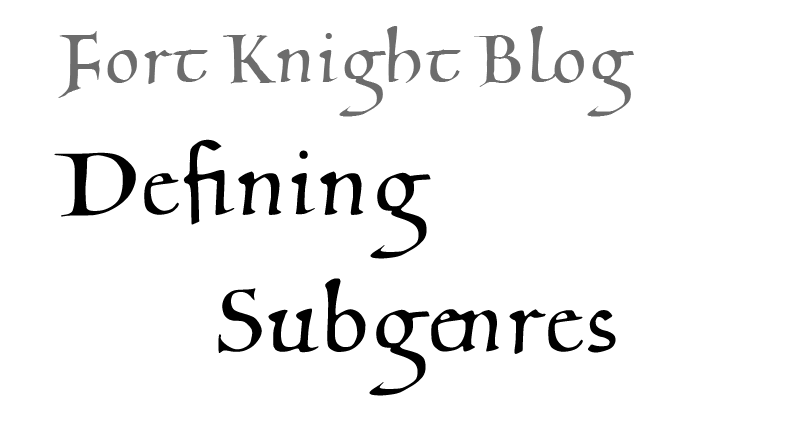Defining Subgenres
How can you define a subgenre of fantasy?
High fantasy is often described as being set in a fantasy world, and then by the stature of the main cast of the plot. This barely separates it from “Dark fantasy”: typically also associated with a fantasy world, and thus the only differentiation is the style and stature of the cast – stereotypical and epic or magical cast members define the story as “high”, whereas dark, horrifying, or doomed cast members create the “dark” fantasy setting.
What of the story that includes the paladins, wizards, and elves of high fantasy, and the aberrations, violence, and grit of dark fantasy? Can a story be high dark fantasy? Given dark fantasy’s old title of “low fantasy”, this seems wrong, yet it is clearly possible.
This is but the easiest of definitions though – Bangsian Fantasy is defined by use of historical characters in new settings, steampunk, dieselpunk, magepunk, and other -punk subgenres are defined by a gritty setting and the inclusion of modern technology in the existing setting; the differing prefixes created by the new power source – steampunk technology is powered by steam, whereas magepunk technology is powered by magic.
What of contemporary low fantasy, the so-called opposite of high fantasy where the world is fantastical but there is little or no magic or fantastical dressing to define it as such.
The only defining factor of “urban” fantasy, beyond unfortunate gendered stereotypes surrounding it and its purpose, are that it is set in a city.
Well then, what of this story: An eagle-riding paladin and a suppurating aberration from another dimension, set in a city that uses magic and diesel for power, in which the main enemy is George Washington. Is this a “High low dark urban Bangsian magedieselpunk fantasy” story? This is plainly ridiculous, and yet with such loosely defined and mutually compatible subgenres, this is the reality of the literary world fantasy must exist in.
This is, of course, only the tip of the iceberg. I haven’t even touched grimdark, comic, fable, super-, cyber, modernised, juvenile, sword-and-sorcery, legendary, hard, historical, wuxia, weird, Lovecraftian, and many more versions of fantasy.
And yet it is plain that we do not concatenate our subgenre classifications like this. Most works of fantasy are only classified as existing within one or two subgenres, even if they would plainly exist within many more. This, in turn, reveals another problem with current classification standards – how quickly we create new subgenres for our work.
Sometimes, this is justified. Steampunk is a popular genre with a specific ruleset – roughly Victorian era technology that is powered by steam. So when Steampunk served as an inspiration for worlds in which technology was powered by magic, whale oil, or any other material, it was clear that these new stories needed a different definition, as steampunk would not accurately describe them. Thus the prefix was changed – magepunk, cyberpunk, dieselpunk, all were born as writers were inspired to stretch the boundaries of the original genre. However, even here the entire title is not changed, rather the prefix is changed to match the setting; thus perhaps the subgenre is -punk, and there are many minor branches of -punk writing. What good is that for the reader though, when those minor branches are so different? I am personally a big fan of steampunk, and largely disinterested in dieselpunk.
Sometimes this creation of new genres does not seem justified by the writing, however. Urban fantasy is typically only defined by two details – that it is set in a city, and it is presumed to be a more “woman-friendly” form of fantasy. Ignoring the blatant ridiculousness that is the assumption women cannot enjoy regular fantasy, many works of fiction are set in cities, and this is not exactly a sound method of classification. Must we soon create “rural” fantasy for stories set in villages, or perhaps “Coastal wheel” fantasy for use only by stories set in coastal villages that feature a waterwheel?
There must, surely, come a point where there are too many fantasy subgenres to be useful. While it may feel good to know you are the bestselling writer in your chosen subgenre, this factoid is useless when you realise you are one of only three people writing in that subgenre. Websites selling books are already bogged down by the number of subgenres; go to a website like Amazon and many are hidden by necessity as there are simply too many to display on a single page.
Thus the subgenre is failing at its only task – to classify a work in a specific field, and make it easier to sort and find the work in the future. Not only are our many subgenres failing at this task, they are actively ruining previous efforts to sort the fantasy genre.
With that aside aside, however – I am still left with the challenge of how to classify a piece of fantasy fiction. A novel I’m writing currently would comfortably fit into high, epic, and hard fantasy subgenres, with likely many more suitable subgenres as well.
Ultimately, I feel my piece most closely reflects high fantasy; though I would feel comfortable describing it as hard fantasy as well, and thus until I find a better convention or ruleset for classification, I will call my piece high fantasy.
Surely that cannot be it, though – the author’s choice of where to classify? If I title my piece science fiction, or erotic motorcycle repair fanfiction, people may disagree with me, or think I am attempting to mislead them. Perhaps I must simply call my piece fiction; for the time being.
What are your thoughts on classifying fiction into categories, and how would you go about correcting this fantasy classification issue (if you do, indeed, agree that there is one.)



